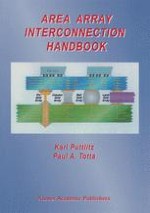2001 | OriginalPaper | Buchkapitel
Wafer Finishing—Dicing,Picking,Shipping
verfasst von : Lyman R. Clark, Mark Brown, Scott Evans, Steve Bedore, Charles E. Gutentag, Robert A. Sierra
Erschienen in: Area Array Interconnection Handbook
Verlag: Springer US
Enthalten in: Professional Book Archive
Aktivieren Sie unsere intelligente Suche, um passende Fachinhalte oder Patente zu finden.
Wählen Sie Textabschnitte aus um mit Künstlicher Intelligenz passenden Patente zu finden. powered by
Markieren Sie Textabschnitte, um KI-gestützt weitere passende Inhalte zu finden. powered by
Progress in die separation technology or “dicing” has improved device yield and productivity over the years. Today, the basic dicing process is one in which a rotating, abrasive-edged blade is positioned to cut in the “streets” or the “kerf” spaces between functional integrated circuits or other devices. The thin, 25 µm cutting blade rotates at very high speeds (30,000 to 60,000 rpm with blade-edge linear speeds of 83 to 175 m/sec). Dicing equipment has evolved over the years from simple, manual systems to fully automatic systems with automatic alignment, auto-handlers, dual spindles and quality monitoring systems. As device technology has evolved, so has the requirement for dicing saw manufacturers to meet the ever-increasing needs for higher precision, greater throughput and reduced damage to the topside and bottom-side edges of the dice. In this chapter, the reader is introduced to the dicing process and made aware of the key issues which must be considered when setting up a die separation process [1, 2].
